Homepage > Maths curriculum > KS1 maths
Learn all about the topics covered in KS1 maths, explore our free resources and have a go at some practice questions!
• What do children learn in the KS1 maths curriculum?
• Topic guides and practice questions
• KS1 maths resources and activities
• KS1 maths SATs: guides and resources
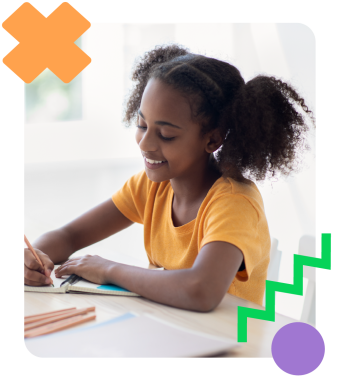

Select a topic
Explore the topics covered in KS1 maths and have a go at some fun, interactive practice questions!
Number and place value

Learn how to count, read and write numbers up to 100
Find out more
Addition and subtraction

Explore strategies for mental and written problem solving
Multiplication and division

Discover key multiplication and division facts

Find out about data and how to read bar charts and graphs
Measurement

Explore time, volume and length and quantities

Learn how to identify 2D and 3D shapes
Position and direction

Discover how to arrange objects into patterns
Fractions, decimals and percentages

Learn what a fraction is and how to order them
Choose a year group
Select a year group.
Take a look at the skills children learn in each year group and have a go at some questions
What do children learn in KS1 maths?
In Key Stage 1 (KS1), kids explore a wide breath of content to help develop their knowledge of core concepts and gain an understanding of how maths is used in everyday life. From fractions to shapes, they learn lots of key skills that’ll place them in great stead for KS2! The main topics they learn about are…
1. Number and place value: In the KS1 maths curriculum, children learn to count, read, write and represent numbers up to 100. They also learn how to compare numbers and use the place value system.
2. Addition and subtraction: Children learn various strategies for mental and written addition and subtraction. They also explore number bonds, counting techniques and inverse operations.
3. Multiplication and division: Kids develop their understanding of multiplication and division and learn how to solve problems using multiplication and division facts, arrays and pictorial representations.
4. Fractions : Learners discover how to recognise, name, find and write fractions in relation to length, shapes and quantity.
5. Measurement: In KS1 maths, children learn how to use appropriate units, estimate measurements and read scales, including length, capacity and time.
6. Properties of shapes: Learners explore the fundamentals of shapes, including how to recognise and name different types of 2D and 3D shapes.
7. Position and direction: Children learn how to describe position, direction and movement, as well as how to organise objects into patterns and sequences.
8. Statistics: In the KS1 curriculum, kids explore how to collect and organise data. They also learn how to create graphs and interpret data using a variety of graphs.
Meet Doodle, the personalised maths app that explores the whole KS1 curriculum!
Created by our team of teachers, DoodleMaths is an award-winning maths app that’s filled with interactive questions and games covering the whole KS1 curriculum.
Designed to be used for just 10 minutes a day, it creates every child a unique learning experience tailored to their needs, boosting their confidence and ability in maths. And best of all, you can try it for free !

Frequently asked questions about KS1 maths
DoodleMaths is an award-winning app that’s filled with fantastic maths games for KS1!
From working in a messy bakery to helping a monkey collect coconuts, all of its games are specifically designed to develop instant recall and mental maths skills, transforming learning into a fun adventure.
Best of all, all of its questions feel like a game, with every exercise using interactive activities and explanations to help bring the subject to life!
Create an account today to enjoy a free 7-day trial .
There are lots of ways that you can help your child or pupils to learn KS1 maths:
- Rather than explaining concepts, use visual representations to explore them, such as number lines and grids.
- Nothing beats doodling! Encourage your child or pupils to draw pictures to help them understand concepts or have a go at working out the answer to a question.
- Use real-life items to explore number, such as Smarties or pebbles. Encourage your child to sort the items into different amounts; doing this will help them understand concepts such as addition and fractions!
- Boosting their instant recall skills will help them with their mental maths and speed answering questions. Learning times tables in a specific order and using fun activities is a great way to help with this!
An array is an arrangement of items (such as pictures or numbers) in columns or rows.
They let children visualise what happens when they multiply or divide numbers together, helping them master times tables and division!
Reasoning is basically detective work: it’s when learners use what they already know to work out the answer to a question.
For example, if a child knows what 12 – 5 is, they can use this knowledge to work out what 12 – 6 is.
“I know that 12 – 5 is 7. As 6 is 1 higher than 5, the answer must be 1 higher than 7.”
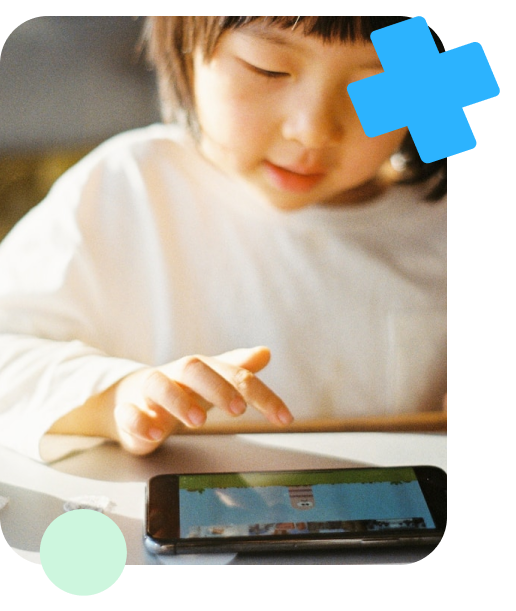
KS1 maths resources and activities
Looking for even more ways to support your child or pupils’ learning? We’ve got you covered!
How to improve at mental maths

Discover our top tips to help any child master mental maths!
Outdoor learning activities for KS1
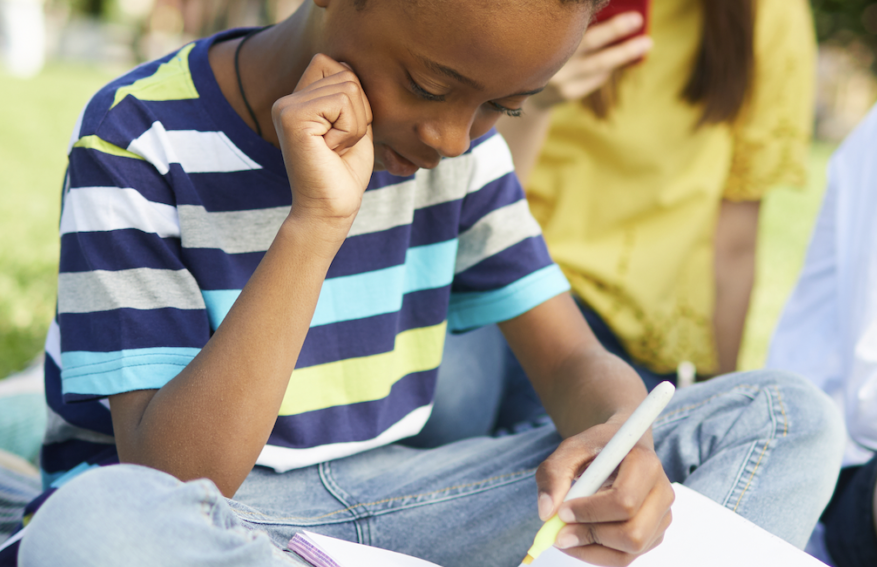
When the sun is shining, there’s nothing better than taking your learning outside!
How to support your child's home learning

Practising maths ‘little and often’ is the perfect way to help kids develop their skills
Discover our top tips to help any child master mental maths!
When the sun is shining, there’s nothing better than taking your learning outside!
Practising maths ‘little and often’ is the perfect way to help kids develop their skills
KS1 maths SATs: guides and resources
In Year 2, children complete maths and English SATs papers. Explore what’s covered in the exams and how you can help your child or pupils prepare for them!
KS1 SATs papers 2024: what's included?
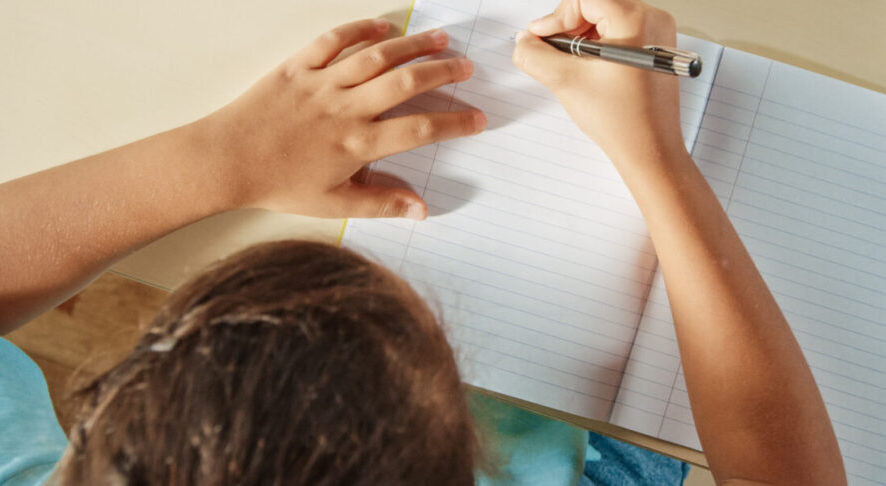
See what’s covered in KS1 SATs and how you can help your child prepare for them
How Doodle can help kids prepare for SATs
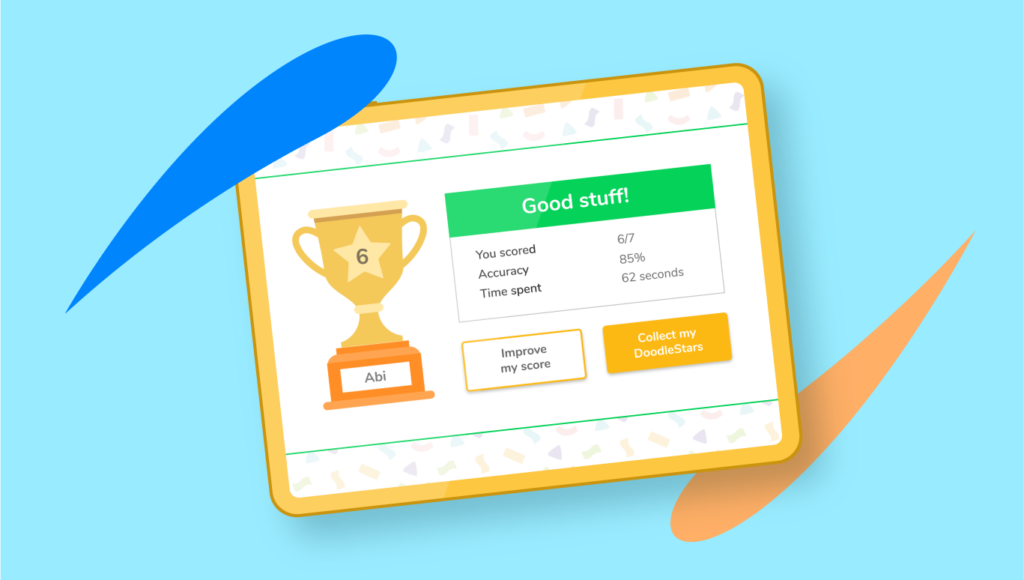
Our apps cover the whole KS1 curriculum, making them perfect study buddies
How to help your child prepare for SATs

SATs may seem worrying, but these tips will help calm your child (and you!)
KS1 SATs papers: what's included?
See what’s covered in KS1 SATs and how you can help your child prepare for them
Our apps cover the whole KS1 curriculum, making them the ultimate study buddies

Try our KS1 maths app for free!

What we offer
Quick links
All rights reserved.

Are you a parent, teacher or student?
Get started for free!
Intervention information pack
We ask for your contact info so we can send our info pack directly to your inbox for your convenience, english and spelling information pack, maths information pack, exam prep information pack, case studies information pack.
Book a chat with our team

I’m new to Doodle

My school is already using Doodle

Information pack
We ask for your contact info so that our education consultants can get in touch with you and let you know a bit more about doodle., student login, which programme would you like to use.
DoodleMaths
DoodleTables
DoodleEnglish
DoodleSpell
If you’d like to use Doodle’s browser version, please visit this page on a desktop.
To log in to Doodle on this device, you can do so through our apps. You can find out how to download them here:
Teacher-Trusted Tutoring
Personalised one to one tutoring that boosts confidence and doubles progress
FREE daily maths challenges
A new KS2 maths challenge every day. Perfect as lesson starters - no prep required!

24 Fun KS1 Maths Games And Activities To Play At Home And School
Emma Johnson
We’ve brought together 24 of the best KS1 maths games to give teachers and parents some new ideas on how to improve pupils’ numeracy in and out of school.
At KS1, maths games, such as multiplication games , are a great way to motivate, engage and inspire children while still having fun. Children in key stage 1 are ready to start practising and developing a whole range of maths concepts and skills, particularly their fluency and strategic thinking.
Inevitably, some people consider these sorts of educational games to be an ‘end of term’ or ‘filler’ activity in the classroom, when they are actually an excellent way of helping children learn basic number facts and explore fundamental number concepts at any time.
When searching for fun maths games on the internet, a large number of search results are often for digital online games. While these too have their place, they aren’t always practical to manage with a class of 30.
In this blog, I will be introducing a range of non-digital games that are interactive in a different sense. While all these maths games are all suitable for primary school children in key stage 1, you’ll find, as with many maths activities, they aren’t restricted to one year group and can be easily adapted to suit children of different ages. They can also be adapted for use in small groups and learning interventions , as well as whole class environments.
Don’t forget to download the printable resources required for a few of the KS1 maths games.
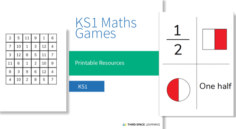
KS1 Maths games printables
All the printable resources you'll need to complete these games
- 1. Number game: battleships
- 2. Number game: total of 10
- 3. Number bonds game: make 10 pyramids
- 4. Mental addition and subtraction game: bowling
- 5. Place value game: sorting and matching
- 7. Addition and subtraction game: grab
- 8. Addition game: ‘pig’
- 9. Place value two digit number game: in the bucket
- 10. Addition maths game: skunk
11. Addition maths game: make 20
- 12. Maths fluency game: maths fact top it
- 13. Addition and subtraction game: guess my number
- 14. Shapes game: what shape am I?
- 15. Maths dice game: ten sided dice rounding game
- 16. Maths fractions game: snap
- 17. Addition war
- 18. Times tables game bang bang
- 19. Maths, paper, scissors
- 20. The yes / no mental maths game
- 21. Number bond bingo
- 22. Target 50
- 23. Addition turnover
- 24. Number 4 in a row
Maths games for year 1
In year 1, children continue learning to count to 100, represent numbers in different ways and read and write numbers to 20. They are encouraged to learn their number bonds to 20, alongside the corresponding subtraction facts. Many of the games in year 1 are aimed at improving fluency and the learning of basic maths skills.
1. Number game: battleships
In year 1, children need to be able to read and write numbers to 100. This is a great game for developing number sense and practising reading numbers.
What you will need to play:
- A hundred square (see downloadable resource pack)
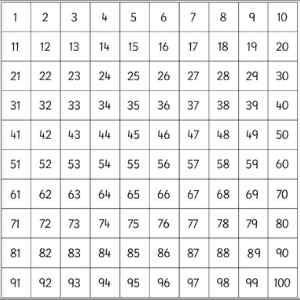
How to play:
- Both players position themselves so they can’t see each other’s hundred square or number square .
- Each player places counters on the hundred square to represent 3 battleships (3 counters long, 4 counters long and 5 counters long).
- Players take it in turns to call out a number. If they hit a battleship, they take the counter. If they miss, the other player marks an x on that number on the hundred square.
- The winner is the first player to ‘sink’ all 3 battleships.
2. Number game: total of 10
This is a simple KS1 maths game to help children practise their number bonds to 10 and number bonds to 20
- 1 or more players
- A pack of cards with the picture cards removed. Ace is worth 1.
- Shuffle the cards and lay out face up into 4 rows of 5 cards.
- The aim of the game is to remove all the cards from the table in sets of 2 or more cards which add up to 10. E.g. an 8 and a 2 could be removed and a 3, 5 and 2 could also be removed.
- The game can be played individually, with players trying to clear as much of the table as they can.
- If played with other players, take it in turns to remove cards. The winner is the person to have removed the most cards by the end of the game.
- The game can also be played using number bonds to 20, by finding cards which add up to 20.
3. Number bonds game: make 10 pyramids
This is another fun KS1 maths game for practising number bonds to 10.
- 1 or 2 players.
- A pack of cards (with picture cards removed) Ace is worth 1
How to play :
- This game can be played individually or against another player.
- Shuffle the cards and set out in the shape of a pyramid, with 6 cards on the bottom, up to 1 card at the top. Make sure the cards are overlapping, as in the picture below.
- The aim of the game is to remove all the cards which make 10. This can be 10 on it’s own, or 2 cards which add up to 10.
- Only cards which aren’t covered by another card can be removed, so players have to start with the bottom row.
- If a pair of cards which add up to 10 can’t be made, the player takes a card from the pile at the side.
- If they still can’t make a pair, they put the card in the discard pile and take another card from the face down pile.
- If playing with another player, each person takes it in turns to try and make 10. If playing alone, keep on going until all the cards have been used.
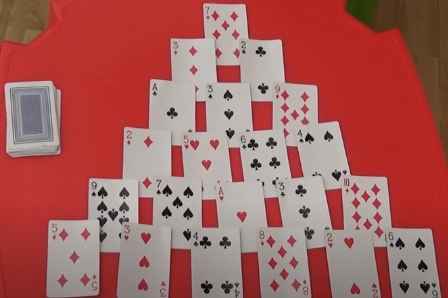
4. Mental addition and subtraction game: bowling
This is a fun, active way of practising subtraction using subitizing and mental addition.
- 2 or more players
- A set of 6 bottles (to act as skittles) with circle stickers set out in patterns.
- A tennis ball
- Paper and pen
- Set out the ‘skittles’ (water bottles)
- Children take it in turns to bowl their ball.
- They check the skittles that have been knocked over and add together the total on each skittle.
- If they are correct, they get to keep the score from the fallen skittles. This is recorded.
- The winner is the player with the most points at the end of the game.
5. Place value game: sorting and matching
In year 1, children need to be able to identify and represent numbers using objects and pictorial representations. This sorting and matching activity is a good way to practise this skill.
- Multi-link cubes
- Dienes base 10
- Using the multi-link cubes, children make stacks of varying sizes, from 1 to 10 cubes in length.
- Ask children to order the stacks of cubes from smallest to largest.
- Once this is complete, ask the child to turn away, mix up the stacks and add some Dienes base 10.
- Children need to match up the Dienes pieces with the corresponding stack of cubes.
- Children working at a different level can be extended further by sorting them into 2 groups – odd and even numbers.
- Paper and pen
- Both players throw 2 dice and add the 2 numbers together. The player with the highest answer wins the round
- The winner is the first player to reach 10 points.
- The game can be adapted by using 10 sided dice, or by adding a third dice.
7. Addition and subtraction game: grab
In this KS1 maths game, children use concrete resources to practise their addition and subtraction skills. They also get to practise writing out number sentences.
- 2 bowls filled with cubes or other small objects
- Paper and pen.
- This game can be played individually or as a speed game against another player.
- Grab a handful of objects from each bowl, count how many in each pile and write out an addition or subtraction sentence (remind children that the largest number needs to go first if they are practising subtraction).
- If playing against another player. Both players take a handful, then race each other to write out the addition/subtraction number sentence.
8. Addition game: ‘pig’
This is a simple KS1 maths game for practising mental addition skills.
- The first player roles the dice and if the dice lands on a 2, 3, 4, 5 or 6 , they can either record the number and let the other player have a turn, or throw again to try and increase the total.
- The aim of the game is to be the first player to reach 100, by throwing a dice and adding to the total each time.
- If a 1 is thrown at any stage, the player loses all the points for that round and score zero.
- The game can also be played with 2 dice, with players adding the totals of both dice each time. If at any stage, they thow two ones, then not only do they lose any points from that round, but they lose all the points gained in the game so far.
Maths games for year 2
In year 2, children are expected to read and write numbers to 100 and recognise the place value of each digit in a 2-digit number. Children will continue to build upon the addition and subtraction skills gained in year 1 and build on their understanding of basic fractions. For our games in this section, we’ll be focusing on place value, basic addition/subtraction and simple fractions.
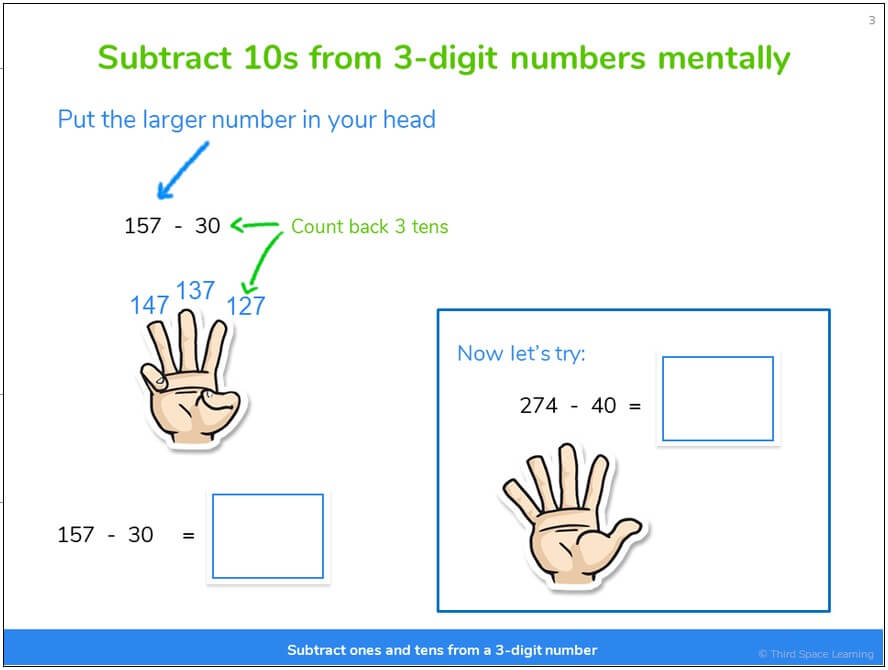
9. Place value two digit number game: in the bucket
In year 2, children are expected to identify and recognise each digit in a 2-digit number. This game is great for helping children to understand place value.
- 2 or more players.
- 2 boxes or buckets
- A selection of 2-digit number cards from 10 to 99
- Player one takes a 2-digit number card
- The aim of the game is to use bean bags to make that 2-digit number.
- The 2 boxes/buckets represent the tens and the ones. Children need to try and get the correct number of beanbags into each box, to represent the tens and the ones.
- If the card selected has 54 on it, the player needs to attempt to get 5 bean bags in the ‘tens’ box and 4 bean bags in the ‘ones’ box.
- Players score a point if they get the bean bags into the correct boxes.
- This game can also be played as a relay race with 2 teams competing against each other.
This video shows an example of how this game can be played at KS2 for numbers greater than two digits. Please note that for KS1 this game would only require 2 buckets as you would only be working with 2-digit numbers.
10. Addition maths game: skunk
This is another great KS1 maths game for practising addition skills, whilst getting children to think about the best strategy.
- Write the word skunk and separate each letter into a different column on a sheet of paper. Each letter of the word ‘skunk’ represents a different round of the game.
- The first player rolls a pair of dice and works out the total of the two dice. The score is written in the S column. If they roll a one they score zero.
- Once they have their first score under the letter ‘S’, they have to make the decision to either stop and take that score as their score for the game, or roll again and hope they score even more to add to the first round score.
- If they roll a one in the second round, play stops and the player takes the score from the first round as their total for the game. The risk a player takes in moving on and throwing again, is if two ones are thrown, all the points for the game are wiped and the player scores zero.
This KS1 maths game is great for practising addition of numbers up to 20. The speed element helps children work on their fluency.
- One or more players
- Post it notes with the numbers 0-20
- A large circle (this can be a hoop or a circle draw on paper)
- Put the circle in the middle and place the post-its around the outside.
- This is a speed game in which players need to match the pairs of post-it notes which equal 20 and stick them in the circle.
- Time the player to see how quickly they can make all the pairs. This is then either the target time for the other player, or their own target time, if they are playing alone.
12. Maths fluency game: maths fact top it
This is another good KS1 maths game for building fluency of addition and subtraction facts.
- A set of maths fact flash cards which you can create yourself based on children’s prior knowledge of addition or subtraction up to 20 Eg. 7 + 5, 9 + 6, 2 + 11
- Players divide up all the maths fact cards and hold in their hands. On the count of 3, each player throws down one card.
- The card with the highest total wins all the cards. If 2 players have the same answer, they play each other again.
- The winner is last player left in, once all the others have lost all their cards.
13. Addition and subtraction game: guess my number
In this game, children use information available to them to work out their mystery number. This is a fun way to practise missing number addition and subtraction.
- 3 players – 2 playing and 1 leading
- A set of 1-10 digit cards
- Lay the 10 cards face down on the table.
- Each player selects a card and without looking at it, holds it to their forehead, so the other player can see it.
- The child chosen to lead the game calls out a statement about the 2 cards, such as ‘the 2 numbers added together equal…’
- Each child has to look at their partner’s card to work out what their own number must be.
- The winner is the first one to call out the correct number.
14. Shapes game: what shape am I?
In year 2, children learn to identify and describe the properties of 2D shapes and 3D shapes. This game is good for practising this and can be played as either a 2D or a 3D shape game.
What you will need to play?
- Pictures of 2D or 3D shapes for children who need them.
- Each player chooses a shape and writes 5 statements about their shape.
- The aim of the game is to be the person who asks the least number of questions to work out the other player’s shape.
- Players need to make their first statements vague, to encourage the other player to ask more questions. E.g. ‘My shape is 2D’, ‘my shape has 3 sides’, ‘my shape has 6 faces’ etc..
- After a player receives a statement on the mystery shape, they can choose to make a guess, or ask for another statement. If they guess correctly after the first statement, they get the full 5 points. If they guess after two statements, they get 4 points, and so on…
- If they make a guess and it is incorrect, they receive 0 points for that round.
- The aim of the game is to be the player with the most points at the end of the game.
15. Maths dice game: ten sided dice rounding game
This simple Ks1 maths game helps children to understand the concept of rounding up and down.
- A 10-sided dice
- Players take it in turns to throw the 10-sided dice.
- One player has the rounding down numbers 1, 2, 3, 4 and 10 (which represents 0). The other player has the round up numbers 5, 6, 7, 8 and 9.
- Take it in turns to throw the dice. If it lands on one of the rounding down numbers, that player scores a point. If it lands on one of the rounding up numbers, the other player scores a point.
16. Maths fractions game: snap
In year 2, children learn to recognise the fractions 1/3, 1/4, 1/2, 2/4 and 3/4. This game is a fun way of practising this.
- A set of fraction cards (see downloadable resource pack)
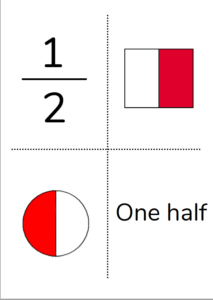
- Shuffle the cards and share out between the 2 players.
- Each player places their pile of cards face down on the table.
- Players take it in turns to turn over a card. If 2 consecutive cards have a matching fraction and picture, the first player to put their hand on the pile and shout ‘snap’ wins all the cards.
- Players then begin again. The winner is the last person to lose all their cards.
More useful year 2 resources: Year 2 Curriculum Toolkit
Mental maths games KS1
Mental maths games are great for building fluency. Many of these games need minimal or no resources and are quick and easy to set up. They can be played at any point during the maths lesson, or as a filler activity at any point in the school day.
17. Addition war
By the end of KS1, children should be able to use and recall addition and subtraction facts to 20. This game is a fun way of practising this skill, with the speed element enabling children to work on fluency.
- A set of playing cards with the picture cards removed (Ace is worth 1)
- Share between the 2 players, so they make 2 piles, face down on the table.
- At the same time, both players turn over a card from their pile and place it in the middle of the table.
- The aim of the game is to add both numbers together and be the first to call out the answer.
- The first person to call out the correct answer gets to keep the cards.
- The winner at the end of the game, is the person who has collected the most cards.
18. Times tables game bang bang
This is a fun KS1 maths game for practising times tables (in this case the 5 times table). It can be adapted to suit other times tables or mental maths skills, such as addition and subtraction of numbers to 20 or number bonds to 10 or to 20.
- 2 players at a time, but a whole class game.
- 2 players stand at the front of the classroom back to back, cowboy shootout style.
- The teacher, or the game leader calls out a number. Players have to work out how many groups of 5 are needed to make that number. For example, if the teacher calls out ‘40’, the players need to call out 8 as there are 8 groups of 5s in 40; 8 x 5 = 40
- The first player to turn, face their opponent, shout ‘bang bang’ and give the answer wins the round.
- Another member of the class then comes out to the front as ‘the challenger’.
- The winner is the last person standing once time runs out.
19. Maths, paper, scissors
This is a KS1 maths game that requires no set-up and is great for building fluency with addition and subtraction facts.
- 2 players
- Both players stand facing each other.
- Similar to the traditional game of ‘paper, scissors, stone’, players hold one hand out in front but this time call out ‘maths, paper, scissors’. On ‘scissors’, they hold out any number of fingers.
- Players then have to race to add together the number of fingers they are holding out to the number of fingers the other player is holding out.
- The winner is the first player to call out the total.
- This can be adapted by having both children using 2 hands, to make larger numbers.
- The game can also be played as a subtraction game, subtracting the smallest from the biggest number.
20. The yes / no mental maths game
This is another quick and easy KS1 maths game to set up and can again be played at any time, when there’s a spare few minutes.
What you need to play:
- 2 or more players.
- One player thinks of a number between 0 and 20.
- The aim for the other player (or the rest of the class, if playing as a whole class) is to ask questions to work out the number.
- The questions can only have the answer ‘yes’ or ‘no’.
- For example, the number could be ‘16’. Children can ask questions such as, ‘is it an even number?’, ‘is it greater than 10?’ ‘Is it less than 18?’
- The winner is the player to have worked out the mystery number with the fewest number of questions asked.
21. Number bond bingo
This is another fun KS1 mental maths game which gets children practising number bonds to 10 and to 20. It is a good game for playing as a whole class.
- 3 or more players (can be played as a whole class)
- A piece of paper and pen for each player
- Choose one person to be the leader of the game. In a whole class situation, this could be the teacher.
- Children write down 5 numbers (under 10 if practising number bonds to 10, or under 20 if pracising number bonds to 20)
- The leader of the game then calls out numbers (under 10 or under 20).
- If a number is called out and players have the number which will make it a number bond to 10 or to 20, they cross out that number. E.g: If the teacher calls out ‘7’ and player with the number ‘3’ on their board can cross it out, or ‘13’ if they are playing number bonds to 20.
- The winner is the first person to cross out all their numbers and shout ‘bingo’
22. Target 50
This is another KS1 mental maths game which is quick and easy to set up and great for practising addition fact fluency.
- 2 or more players (can be played as a whole class)
- A dice
- Pen and paper
- Split the class into 2 teams
- The teacher rolls the dice (this can be a digital dice online) and team 1 adds up the numbers thrown. The teacher continues rolling until either a ‘1’ is thrown or until the teams tells them to ‘bank’ the total so far.
- The first team to reach 50 is the winning team.
More mental maths resources
- 33 Mental Maths Strategies Every Child Should Know
- Nail Your Number Facts
- What Are Number Bonds?
Problem solving games KS1
Problem solving games are a great way for children to deepen their mathematical understanding. These games require children to think strategically and to approach problems in different ways.
23. Addition turnover
This KS1 maths game is great for developing addition skills, whilst encouraging children to think strategically.
- 1 or 2 players
- A pack of cards (2 – 10 cards only)
- This game can be played individually or against a partner.
- Shuffle the cards and lay 18 cards out in front, at 3 rows of 6.
- Throw 2 dice and add the numbers together.
- Turn over the playing cards to match the total on the dice. For example, if a 5 and 4 are thrown, the player needs to turn over cards which total 9. This could be 1 or more cards.
- The other player then does the same.
- The aim of the game is to be the player with the most cards once all the cards have been cleared.
- Players need to think tactically when playing, using the combination of cards which enables them to remove the most cards in one go.

24. Number 4 in a row
This KS1 problem solving game enables children to practise their addition and subtraction skills and encourages them to think tactically, not only about their own counters but also about those of their partner’s
- A 6 by 6 grid containing the numbers 2 to 12 (see downloadable resource pack)
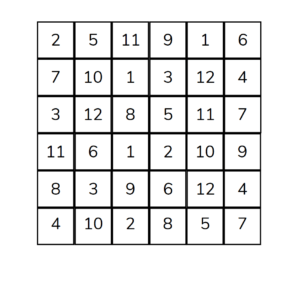
- The first player throws the 2 dice and adds the 2 numbers together. They then place a counter or colour in a square containing that number.
- The 2 nd player does the same, placing a different coloured counter on the grid, or colouring in with a different colour.
- The aim of the game is to be the first player to cover 4 squares in a row (horizontally, vertically or diagonally).
- Children aren’t only thinking about how to make a line of 4 themselves. They also need to think about blocking the other player from making a row of 4.
Looking for more fun games to boost pupils’ learning? Look out for our top 25 maths games you can do at home, 26 KS2 maths games as well as our favourite times tables games and place value games .
Hopefully this blog has given you some ideas for games you could play in your classroom. Most are easy to adapt, to suit any age or the topic you are covering. Don’t just adapt the maths games yourself. Give children the opportunity to adapt and think up their own rules too.
Download your free KS1 Maths Games Printable Resource Pack here!
If you want to engage children more fully with maths, Third Space Learning’s online maths lessons provide one to one support that’s personalised to children’s needs. Tutors make lessons fun, and match the interests and previous maths experience of the child being taught.
DO YOU HAVE STUDENTS WHO NEED MORE SUPPORT IN MATHS?
Every week Third Space Learning’s specialist school tutors support thousands of students across hundreds of schools with weekly online 1 to 1 maths lessons designed to plug gaps and boost progress.
Since 2013 these personalised one to one lessons have helped over 150,000 primary and secondary students become more confident, able mathematicians.
Learn how the tutoring integrates with your SEF and Ofsted planning or request a personalised quote for your school to speak to us about your school’s needs and how we can help.
Related articles

The Best Free Multiplication Games To Play At KS1 & KS2 For Classroom Engagement

9 Coronation Maths Activities For Schools: Coronation Fun For KS1 and KS2
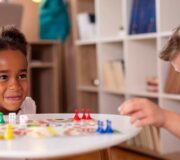
18 Brilliant Mental Maths Games To Build Number Fluency, Speed And Stamina In KS1 & KS2

The 24 Best Free KS3 Maths Games For Engagement At School and Home
FREE 12 Maths Club Activities for Primary Schools (Years 1 to 6)
A collection of games and activities to make maths enjoyable in a primary school maths club!
Minimal resources are needed for each activity.
Privacy Overview
Cookie Consent
We use cookies to help provide a better website experience for you, and help us to understand how people use our website. Our partners will also collect data and use cookies for ad personalisation and measurement.
Clicking "Accept" will allow us and our partners to use cookies, learn more in our cookie policy or to change your cookie preferences, click "Manage".
To find out more about cookies and the types of cookies we are setting please visit our cookie policy .
If you'd prefer that certain types of cookie are not saved on your browser when visiting our website, use the toggles below to adjust those preferences and click "Save choices".
Strictly Necessary
These cookies are necessary for the website to function and without them you would not be able to reliably use the website. For example, logging into your account or completing forms.
Analytics Cookies
A series of cookies that collect anonymised data on how users interact with our website. This anonymous data helps us improve the website with a focus on its users, for example, ensuring the most popular content is easier to access.
View associated providers +
Marketing Cookies
These cookies track your online activity to help advertisers deliver more relevant and personalised advertising or to limit how many times you see an ad. These cookies can share that information with other organisations or advertisers.
Play of the Wild
Education is an admirable thing, but it is well to remember from time to time that nothing that is worth knowing can be taught. -Oscar Wilde

Outdoor Maths Activities KS1 -Maths Outdoor Learning

Outdoor Maths Activities KS1 -Maths Outdoor Learning
The following is a list of some of my favourite outdoor maths learning activities for KS1 (Key stage 1 – ages approximately 5-7). Maths in outdoor and outside learning is a fun way for children to use maths in real, hands-on situations. It also promotes making connections between different areas of maths learning.
Younger children, in particular, need the experience of manipulating real-life materials and exploring mathematical thinking. These experiences help them to develop an understanding of the value of numbers, and later, what happens during arithmetic operations. Children need to have a wide variety of opportunities to practice counting and problem solving using tangible objects. It allows them to develop a deep understanding of numbers, number facts and the changes that take place during various operations (Anghileri, 2006). It does take children longer to learn through exploration and hands-on methods rather than learning by rote. However, they will gain a deeper understanding, including how and why they work, rather than just the process (Carruthers & Worthington, 2004). In the long-term, this will help them to build confidence in maths, as well as allow them to apply their knowledge in problem-solving.
Outdoor Maths Activities KS1
I have grouped theses outdoor maths activities based on different areas of learning for KS1. They are primarily for children ages 5-7, but they can be adapted for younger and older children. You can also see my post on Outdoor Maths for KS2 or Outdoor Maths for EYFS for more ideas.
*Please note that this post on Outdoor Maths Activities for KS1- Outdoor Learning contains affiliate links to help with the running cost of this website. Thank you for your support so that we can keep writing!
Number & Place Value (including counting)
- Counting objects from nature – This might include doing nature hunts for a certain number of objects and even counting objects with number frames or numicon for support. Collecting objects provides many opportunities for counting and learning maths in the outdoors.

- Number rocks or number logs – Children can practice ordering numbers, and then may go on to practice ordering/counting by 2s, 5s (e.g. skip counting).

- Number games – Children may play number games with rocks – ex. Swapping numbers or missing number games .
- Nature number line – Hang rope between trees (or along the fence if concerned about children running into the rope) and provide pegs. Children can hang up and order numbers to make a number line. Children might collect things like leaves to pin to correspond with the value. Which number comes first? Which number is bigger (has a larger value)? How do you know?

- Place Value – Place value frame (e.g. tens and ones) with sticks or rocks- Children can practice representing tens and ones using, for example, 1 stick for each 1 and a bundle of 10 sticks for each ten (or children may swap a large rock to replace a bundle of 10 sticks). Ex. 35 can be shown by 3 bundles of sticks and 5 sticks or 3 large rocks and 5 sticks (or even pebbles). Which is greater? Which is less? Can you prove it?

- Number bonds – Practice number bonds to tens with sticks or rocks. Children can find all the ways to add two numbers together to make 10 (and even all numbers 1-10). For even deeper learning children can explore combining 3 or more values to add up to 10 (or numbers to 10) (see below in arithmetic). Is there a way to check you have found all the number bonds? Can you record them? Show me…
- Greater or less than – Children can practice representing greater than or less than with sticks. They can see this visually by fitting in rocks (see example below) to see which is bigger or smaller < >. Which is greater? Which is less? How can you prove it?

- 100 square – Make a massive 100 square outdoors on the pavement with chalk. Children can fill in the 100 square using number rocks or number log slices, or even writing numbers onto the square with chalk. Which number comes first? Do you notice anything about the hundred square? What happens when you count up /down 10?
- Counting picture – Children can work collaboratively to create a picture using 10/20/30 objects they find in nature. Children have to work together to find the objects and make sure they have the exact number of objects.
- Number hunt – children can search for numerals, written out words for numbers, and/or dice or other value representations of numbers hidden outside. They can then match different representations of the same number together (and even order them). How many different ways can you make 5? Children may use things such as a tens frame or numicon to help them represent the numbers.

- Number writing – Children can practice writing numbers with chalk or tracing over chalk numbers by painting with water.
- Parachute or Circle games with numbers – Children can be given a number and then children swap (or run in / out of the parachute or swap places in the circle depending on if the statement is true or falls). For example, the teacher might say odd numbers, even numbers, numbers less than 5, numbers greater than 5, numbers for counting by 2 or by 5, etc.
- Minibeast Counting – Go on a minibeast hunt and have children count and keep track of what they find with tally marks or tally chart. You may want to discuss why tally marks work well for this (rather than writing down numbers). You could come together as a large group at the end and create a pictograph using their findings.
- Skip counting – Children can use number rocks to practice skip counting (e.g. practice counting in 2’s, 5’s and 10’s). Children may want to pair the numbers with the corresponding numicon . What do you notice about the numbers when counting in 2’s? What about in 5’s or 10’s?
- Counting in groups – They can use number rocks and natural objects to count out objects in 2’s (or 5’s or whatever they are counting by) and then match with the numeral for each group (e.g. first group of 2 seashells with a number 2, second group of 2 seashells with a number 4, third group of 2 seashells with a number 6, etc.).

- Using leaves for multiplication – Children can practice repeating addition as a way to help them understand multiplication. They can count the blades on the leaves to help them do this. For example, maple and horse chestnut leaves have 5 blades each so children can use them to count in 5’s. Buttercup and clover leaves have 3 blades so children can use them to count in 3’s. What do you notice about counting in 2’s, 3’s, 5’s etc?

- 100 square problem solving – Children can make a large number line or 100 square using rock numbers or chalk (described above in number and place value section). Children can use this to help them solve addition and subtraction problems. As they count up or back along the number line (to add or subtract) they might even step along it (if it is big enough). *As children become confident with adding, they can practise counting on and even counting up in 10’s when adding and subtracting double-digit numbers. What do you notice when you count up or down in 10?
- Nim – Nim is a mathematical strategy game where two players take turns removing objects from a pile. Each player must take at least one object per turn. The goal is to either get or avoid taking the last object from the pile. Children can play nim with a pile of sticks or rocks.
- Number bonds – Children can practice making all the number bonds for numbers 1-10 using sticks or rocks (see above in number and place value). Is there a way to keep track an record your number bonds?

- Counting sets – Children can throw a set number of rocks towards a hula hoop laying on the ground /circle drawn on the ground (this is a way to create number bonds). Then they can count how many rocks land inside and outside of the hoop (as well as count the total). It will help them see that no matter how many different ways they land (e.g. number bonds), the total will stay constant. Similarly, children can explore playing around with a set number of rocks on a number frame to see that it is the same value even when it looks different. Is it still 7? How can you check?

- Skittles & bowling – Children can play games such as skittles , bowling and other target games . They can identify numbers on the games, count the number of skittles or targets that are hit, add up points, take away how many objects have been knocked over, and see how many are left. There are lots of opportunities for counting, adding and subtracting with these types of garden games.

- Garden counting – As children pick tomatoes or other fruits or vegetables from the garden, get them to count how many they picked from each plant. Then how many have they picked altogether?
- Sharing garden crops – As children pick flowers, strawberries, or other things from the garden help them practice using different types of division (e.g. sharing & grouping). For example – [Sharing] if you’ve picked 12 tomatoes how many will we each get (e.g. you & me)? If another child comes along – now how can we share them between us? [Grouping] If we are selling baskets with 6 tomatoes in each basket, how many baskets can we make to sell? How many apples do you need to make a pie?… How many pies can you make with the number of apples you have picked? You might also get into remainders if there are some leftover.

- Drawing fractions – Children can draw a large square on the pavement (or in the sand) and then find different ways to shade in ½. This is a great way for them to see that ½ can look different, but it always must add up to the same amount. As children advance, they can see how many different ways they can make ¼ or 1/8. How do you know its ½ or ¼? Is there a way you can prove it?
- Fractions with sticks – Using sticks can be a great way to introduce children to see fractions visually. If you cut sticks so there is one that is whole, 2 that are ½ , and 4 that are ¼ they can see visually how fractions are divided up. It also makes it easy to see how 2(½) = 1 and ½ = 2(¼).
Measurement
- Ordering objects by length – children usually find it easy to compare two objects but may need more practice when comparing 3 or more objects. I have a post – ordering sticks by length , which reviews common misconceptions, ways to help children to learn this and questions to ask. Which is longer? Which is the longest? How can you prove it?

- Measuring with non-standard units – Children can practice measuring objects with non-standard units (e.g. how many stones long is the stick). This is the next step after comparing lengths, but before measuring with standard units such as cm or inches. How many pinecones long is your toy bus? Which is shorter? How do you know?

- Measuring height – Children can measure their height in rocks, pinecones or sticks (e.g. non-standard units) by laying down on the ground. Children can then count to see how many pinecones, sticks, or rocks tall they are. Who is taller? How do you know? Is there another way to show this?
- Measuring natural objects – Children can measure natural objects, such as plants, with a ruler. They can also go on a ‘meter hunt’ or ‘foot hunt’ to see if they can find things in nature that are a foot or meter.
- Meter or foot with natural objects – Children can try making a meter or foot using sticks, rocks pinecones or other natural objects. How many sticks/rocks/pinecones did it take to make a meter?
- They may measure the circumference of a tree.
- Plant measuring – They may also practice measuring the height of plants (e.g. non-standard to start – e.g. 5 sticks high, then with a ruler for standard units).
- Measuring growing – Children can use measuring to help them plant seeds or seedlings. They may use a stick that is 12 inches to help them measure the distance between plants with nonstandard units. Children may then move on to using a ruler to help them measure the recommended distance between seeds or seedlings.
- Chalk clocks – Children may make clocks with sticks and chalk or with rocks, numbers and chalk to practice showing time.

- Counting 1 minute – Children can practice counting how many times you can jump, skip, or hop, or how far you can walk, etc. in one minute. How many did you do? Did you do fewer or more than last time? If you did more/less does that mean you are getting faster or slower? Can you find a way to keep track of how many hops, skips you do in a minute? What else do you think you can do in a minute?
- Timing – They may also time themselves to see how long it takes to run from one point to another, to bicycle 1 mile, to hop 20 times, etc. How can you tell if you are getting faster or slower?
- Potions – Children can make up or follow potion recipes. They can follow instructions to measure (with standard or non-standard units) and combine ‘ingredients.’ Children might also compare relative measurements such as full, half-full, empty, etc. You can challenge children – which container will hold the most potion? How do you know? Can you figure out how to order the containers by which will hold the least to which will hold the most?

- Weighing – Children can use balance scales to compare the weights of different objects. How many horse chestnuts are equal to the weight of your rock? Can you prove which object is the heaviest?
- Measuring garden crops – There are lots of opportunities for measuring when picking fruit and vegetables from your garden. What is the volume of the containers you filled with raspberries? How much do the apples or squash weigh? Which is the longest courgette? Can you order them by length? Can you measure them with your ruler? If you sell some of your crops or are, instead, getting your vegetables at a “pick your own farm”, there are opportunities to discuss money as well. If we have 2 pounds of tomatoes, how much will that cost (ex. at £0.50 per £)?
- Snail Races – see how far a snail can go in one minute. Children can help you think of ways to best measure the snail’s movement. This is also a way for children to help count 1 minute and get an idea of how lone one minute feels like.
- Sorting and ordering – Children can sort / order (gradient) natural objects (e.g. leaves, rocks) by a specific feature (ex. Shape, size, colour, or other features).
- Dam building / Den building – Children use materials such as sticks and rocks to build a fort/den or to block off or dam a stream. They could also build obstacle courses and use directional language to help each other get through it. This is an excellent opportunity for children to practice estimating length and using spatial rotation to help them construct.

- Nature symmetry – Children may explore symmetry in nature. They may use a mirror to help and even make their own creations (see mandalas below).
- Symmetry transient art – They can make symmetrical pictures or mandalas with natural objects .

- Making Patterns – Children can make patterns with natural objects. This might mean repeating patterns, or it might mean making more complicated patterns such as (x+1) or 2x or x2 etc.
- Shapes – Children can make shapes out of sticks, rocks, etc. They can copy over ones drawn in chalk or create their own freehand. To take this further, if children are using objects that are very similar in size/length (e.g. rocks or leaves) they can use them to do a non-standard unit measure of the perimeter – e.g. the rectangle is 1 leaf wide and 3 leaves long. It’s a great way to see the difference between squares and rectangles visually.

- String shapes – Children can use loops of string or large bands to make shapes (this can be done in partners/groups) and see how manipulating them changes the way the shape looks or may turn it into a different shape. How do you make a triangle or a square? Can you show me different ways to make a triangle?

- Shape pictures – Children can draw pictures (in chalk) using 2D shapes. What shapes did you use to make a house, car, etc?
- Shape hunt – Children may go on 2D and 3D shape hunts in nature. Which shape is it? How do you know?

Data Handling
- Pictographs – Children may organise natural objects such as leaves or flowers by features such as colour, size, type, etc. on a pictograph.

- Venn Diagrams – Using hula-hoops to sort objects by two different features (e.g. leaves by colour and size, etc.)

I hope you find this list of outdoor maths activities for KS1 helpful. They can provide a great way to enhance and complement the learning that children do in class. If you decide to try out some maths outdoor learning, let me know how you get on!
References – Outdoor Maths Activities KS1 -Maths Outdoor Learning
Carruthers, E. and Worthington, M. (2004). ‘Young children exploring early calculation’. Mathematics Teaching , (187), 30-34.
Anghileri, J. (2006). Teaching number sense , (Ch. 4, pp. 49-70). London: Continuum.
Arithmetic , Data, Patterns & Sorting , Geometry , Maths , Measurement , Natural , Number & Place Value , Preschooler , Rocks , School Age , Sticks
Dirt , flowers , hands-on learning , Learning Outdoors , Leaves , numerals , numicon , Nuts , outdoor learning , Rocks , Sand , Sticks , Water
4 thoughts on “ Outdoor Maths Activities KS1 -Maths Outdoor Learning ” Leave a comment ›
- Pingback: Hanukkah Math- Dreidel Math Game for Kids – Play of the Wild
- Pingback: Outdoor Maths Activities EYFS – Outdoor Maths Ideas – Play of the Wild
- Pingback: Outdoor Maths Activities KS2 – Teaching Maths Outside – Play of the Wild
- Pingback: Outdoor Learning Planning Frames – East Ayrshire Numeracy and Mathematics
Leave a Reply Cancel Reply
Your email address will not be published. Required fields are marked *
Save my name, email, and website in this browser for the next time I comment.
Notify me of follow-up comments by email.
Notify me of new posts by email.

Every Question Helps You Learn
Key Stage 1 Maths

When you answer 8 or more questions correctly your red streak will increase in length. The green streak shows the best player so far today. See our Hall of Fame for previous daily winners.
Each time you answer 10 questions correctly in a quiz your streak will lengthen.
Join us to pit your skills against the leading streak today and if you win we will publish your username on our Hall of Fame Page.
Enjoyable Learning for KS1 Maths
Discover why quizzes are an easy way to learn and revise the KS1 subjects taught at primary school. Ideal preparation for the Mathematics SATS test papers taken at the end of Year 2 by children who are 6 and 7 years old.
Subjects On This Page
The 99 quizzes in this section have clickable links below. Each quiz contains 10 questions, answers and helpful hints for Key Stage 1 Maths. Quizzes have titles that describe the subject and each one aligns with the KS1 National Curriculum for children aged 5 to 7 in Years 1 and 2.
Mathematics might be one of the trickier subjects for some students (or easier, for those who love numbers) but either way, our quizzes are fun and engaging. We take all the National Curriculum material and pop it into easy-to-digest quizzes that are enjoyable enough to keep students focussed but also challenge them. Hooray for non-complicated revision!
And you already know maths is important. Not only is it likely there will be class tests but students in Primary schools will also have to sit SATS tests with a maths paper. But don't worry, there's plenty of time to prepare! We've got revision covered. The Maths SATS consist of two separate papers: 'Arithmetic' and 'Problem Solving and Reasoning'. The good news? We tackle both areas in the quizzes, meaning revision doesn't have to be dull and tiresome! Phew.
It's not just about school and tests either. Basic maths is important for everyday life! People use maths a lot, even if they don't work as a mathematician or a maths teacher. Simple things like adding up the cost of shopping, or maybe working out how much money to tip the waitress, all involve maths. It might even mean working out how many week's pocket money it'll take to buy that new game...
To find out all there is to know about this curriculum, check out Key Stage 1 (KS1) .
Contact Details
Education quizzes, customer service, here to help, our social circles.
© Copyright 2016-2024 - Education Quizzes Work Innovate Ltd - Design | Development | Marketing
We use cookies to enhance your experience on our website.
To comply with the e-Privacy directive, we need your consent - I agree - No thanks - Learn more

Or search by topic
Number and algebra
- The Number System and Place Value
- Calculations and Numerical Methods
- Fractions, Decimals, Percentages, Ratio and Proportion
- Properties of Numbers
- Patterns, Sequences and Structure
- Algebraic expressions, equations and formulae
- Coordinates, Functions and Graphs
Geometry and measure
- Angles, Polygons, and Geometrical Proof
- 3D Geometry, Shape and Space
- Measuring and calculating with units
- Transformations and constructions
- Pythagoras and Trigonometry
- Vectors and Matrices
Probability and statistics
- Handling, Processing and Representing Data
- Probability
Working mathematically
- Thinking mathematically
- Mathematical mindsets
- Cross-curricular contexts
- Physical and digital manipulatives
For younger learners
- Early Years Foundation Stage
Advanced mathematics
- Decision Mathematics and Combinatorics
- Advanced Probability and Statistics
Counting and Ordering KS1
This collection is one of our Primary Curriculum collections - tasks that are grouped by topic.
Counting Collections in the Early Years
In this article for practitioners, Cath Gripton and Deliah Pawluch explore the 'counting collections' approach, which encourages children to spend time playing and experimenting with counting.
Number Book
Creating a 'Book of Four' provides an opportunity for children to collect groups of four objects and consider how the groups of objects are similar.
Counting Collections
In this activity, children choose collections of items to count and are supported as they find ways to keep track of, and record, their counting.
Estimation Station
This activity involves filling a jar with small objects to encourage estimation and counting skills.
Using Books: Maisy Goes Camping
In this task, the book 'Maisy Goes Camping' by Lucy Cousins introduces children to the idea of using the size and number of objects to work out how many will fit in a 'tent'.
When tidying away toys in this activity, children will use their counting skills to check that all the toys are in the box.
The Voting Station
This task encourages children to count and compare numbers when using 'voting bricks' to vote for a book at story time.
Number Rhymes
In this activity, the rhyme 'Ten Green Bottles' is used to encourage children to count backwards to work out how many bottles are left.
Incey Wincey
In this game, children roll the dice and count how many steps to move the spider up or down the drainpipe.
Beat the Clock
Children use everyday language to talk about time, to compare quantities and to solve problems
Five Steps to 50
Use five steps to count forwards or backwards in 1s or 10s to get to 50. What strategies did you use?
Biscuit Decorations
Andrew decorated 20 biscuits to take to a party. He lined them up and put icing on every second biscuit and different decorations on other biscuits. How many biscuits weren't decorated?
There are three versions of this challenge. The idea is to change the colour of all the spots on the grid. Can you do it in fewer throws of the dice?
Domino Sequences
Find the next two dominoes in these sequences.
Writing Digits
Lee was writing all the counting numbers from 1 to 20. She stopped for a rest after writing seventeen digits. What was the last number she wrote?
Robot Monsters
Use these head, body and leg pieces to make Robot Monsters which are different heights.
Next Domino
Which comes next in each pattern of dominoes?
Same Length Trains
How many trains can you make which are the same length as Matt's and Katie's, using rods that are identical?
Buzzy Bee was building a honeycomb. She decorated the honeycomb with a pattern using numbers. Can you discover Buzzy's pattern and fill in the empty cells for her?
100 Square Jigsaw
Can you complete this jigsaw of the 100 square?
Shut the Box
An old game but lots of arithmetic!
Missing Middles
Can you work out the domino pieces which would go in the middle in each case to complete the pattern of these eight sets of three dominoes?
Making Sticks
Kimie and Sebastian were making sticks from interlocking cubes and lining them up. Can they make their lines the same length? Can they make any other lines?
Grouping Goodies Live
Pat counts her sweets in different groups and both times she has some left over. How many sweets could she have had?
How Would We Count?
An activity centred around observations of dots and how we visualise number arrangement patterns.
That Number Square
How quickly can you put back the numbers on the hundred square? What's the 'best' way to do it?
Have a look at these photos of different fruit. How many do you see? How did you count?
Dotty Six is a simple dice game that you can adapt in many ways.
- International
- Schools directory
- Resources Jobs Schools directory News Search

FREE KS1 Problem Solving - Maths - Home learning
Subject: Mathematics
Age range: 5-7
Resource type: Worksheet/Activity
Last updated
- Share through email
- Share through twitter
- Share through linkedin
- Share through facebook
- Share through pinterest

KS1 problem solving - Number and shape and space problems. A colourful resource that can be adapted. Ideal for home learning during school closures. Answers provided!
Creative Commons "Sharealike"
Your rating is required to reflect your happiness.
It's good to leave some feedback.
Something went wrong, please try again later.
This resource hasn't been reviewed yet
To ensure quality for our reviews, only customers who have downloaded this resource can review it
Report this resource to let us know if it violates our terms and conditions. Our customer service team will review your report and will be in touch.
Not quite what you were looking for? Search by keyword to find the right resource:

IMAGES
VIDEO
COMMENTS
This feature details how NRICH can help you embed a problem-solving approach in your classroom. ... Working Systematically at KS1 - Primary Teachers . Age 5 to 7. ... recognise, extend and explain number patterns. Working Backwards at KS1 . Age 5 to 7. The lower primary tasks in this collection could each be solved by working backwards. Working ...
Primary Resources on Problem-Solving . Perfect for KS1 students, our maths problem-solving primary resources test a range of skills, from addition and subtraction to remainders and number order! We've included challenging topics like negative numbers, using inverse numbers, and remainders, to ensure these primary resources on problem-solving test your students' maths knowledge.
Put the plates in a cross. Use all 15 counters. Put a different number on each plate. Make each line add up to 10. Do it again. This time make each line add up to 8. Solve mathematical problems or puzzles. Know addition and subtraction facts up to 10. Add three small numbers mentally.
Maths - Key Stage 1 (5-7 year olds) Select a Category: Counting Ordering Sequencing Numbers Place Value, Odd and Even Addition and Subtraction Multiplication and Division Fractions Money Shape, Position and Movement Measures Data Handling Problem Solving.
NUMBER AND PLACE VALUE I SEE PROBLEM-SOLVING -KS1 Task A Extend: 2-digit numbers E X T E N D Use 10p and 1p coins. Make 34p Do in different ways. 10p 1p Teacher notes: 4 possible answers: three 10p coins and four 1p coins; two 10p coins and fourteen 1p coins; one 10p coin and twenty-four 1p coins; thirty-four 1p coins.
Explore strategies for mental and written problem solving. Find out more. Multiplication and division. Discover key multiplication and division facts. Find out more. ... Number and place value: In the KS1 maths curriculum, children learn to count, read, write and represent numbers up to 100. They also learn how to compare numbers and use the ...
Number Lines. Age 5 to 7. Challenge Level. A resource to try once children are familiar with number lines, and they have begun to use them for addition. It could be a good way to talk about subtraction. Leah and Tom each have a number line. Can you work out where their counters will land?
Age 5 to 7. Challenge Level. In this game, you throw a dice and move counters along the snail's body and in a spiral around the snail's shell. It is about understanding tens and ones.
Challenge Cards. Use these fun KS1 place value and problem-solving activities in the classroom or at home to aid children in their understanding of key mathematical concepts. Children will have the choice of solving word problems, completing investigations, playing maths mystery games and much more.
This is another fun KS1 maths game for practising number bonds to 10. What you will need to play: 1 or 2 players. A pack of cards (with picture cards removed) Ace is worth 1 ... Problem solving games KS1 . Problem solving games are a great way for children to deepen their mathematical understanding. These games require children to think ...
KS1 Maths Compare Number Bonds within 10 Using Greater than and Less than Activity Sheet. 5.0 (2 reviews) ... The mastery activity cards are a fantastic tool for developing young learners' fluency, reasoning and problem-solving skills. The diving into mastery activity cards have been designed to support the White Rose Maths scheme of work, so ...
Solving maths problems Using a number balance see-saw. This engaging activity is designed for KS1 to enhance students' addition and subtraction skills through a practical and engaging approach! Learners will use a model of a see-saw to balance a range of numbers. They will then decide how many items need to be added or subtracted to bring the ...
Practice is crucial to maths success, and our questions are designed to support your daily routines. These problems can be used across Y1 and Y2 throughout the year. Download. Our maths problems of the day provide four problems across KS1, KS2 and Lower KS3 for pupils to solve. View our Maths resources from White Rose Maths.
2014 National Curriculum Resources Maths Key Stage 1 - Year 1, Year 2 Year 2 Number - Addition and Subtraction Add and subtract numbers using concrete objects, pictorial representations, and mentally, ... Have you seen this lovely problem-solving resource all about finding different ways of making totals using digit cards 0-9? We think you may ...
I SEE PROBLEM-SOLVING-KS1 TASK BUILD-UP Available as PowerPoint and PDF from www.iseemaths.com GARETH METCALFE Spot the Mistakes: 2 2 2 2 2 1 4 2 Odd one out: 5 7 3 1 ... I SEE PROBLEM-SOLVING Number Line Intervals. NUMBER AND PLACE VALUE Put 9 on each number line: Reading Number Lines 8 10 5 10 0 10 0 20 Part 1 I SEE PROBLEM-SOLVING.
Collecting objects provides many opportunities for counting and learning maths in the outdoors. Number rocks or number logs - Children can practice ordering numbers, and then may go on to practice ordering/counting by 2s, 5s (e.g. skip counting). Number games - Children may play number games with rocks - ex. Swapping numbers or missing ...
Key Stage 1 Maths. Enjoyable Learning for KS1 Maths. Discover why quizzes are an easy way to learn and revise the KS1 subjects taught at primary school. Ideal preparation for the Mathematics SATS test papers taken at the end of Year 2 by children who are 6 and 7 years old. ... Year 2 Numbers - Place Value Problem Solving: Play: Year 2 Numbers ...
NUMBER AND PLACE VALUE I SEE REASONING -KS1 Number lines 0 5 Show 10 on each number line. 0 3 0 8 Number lines The number in the box is larger. 0 0 10 20 blue OR red. NUMBER AND PLACE VALUE I SEE REASONING -KS1 Number lines 30 35 Show 34 on each number line. 30 40 0 100
These maths problem-solving worksheets include word problems to challenge your KS1 pupils. Easy to download and use. Includes an answer sheet for easy marking. ... They work for numbers between 0 and 20 so are ideal for EYFS and KS1 pupils. You can use a number line to support this activity with younger children.
Counting Collections. Age 3 to 5. In this activity, children choose collections of items to count and are supported as they find ways to keep track of, and record, their counting.
pptx, 2.35 MB. pdf, 3.51 MB. These booklets each contain over 40 reasoning and problem solving questions suitable for KS1, KS2 and KS3 classes. These are the questions that we have been putting out each day in March 2016 on Twitter in the run up to SATS. The answers are provided with some simple notes at the back of the booklet and for some ...
FREE KS1 Problem Solving - Maths - Home learning. Subject: Mathematics. Age range: 5-7. Resource type: Worksheet/Activity. File previews. docx, 50.7 KB. KS1 problem solving - Number and shape and space problems. A colourful resource that can be adapted.